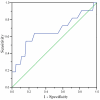The psychometric properties of Beck Depression Inventory for adolescent depression in a primary-care paediatric setting in India
- PMID: 17688697
- PMCID: PMC1976414
- DOI: 10.1186/1753-2000-1-8
The psychometric properties of Beck Depression Inventory for adolescent depression in a primary-care paediatric setting in India
Abstract
Background: There is increasing interest in identifying adolescents with depression in primary care settings by paediatricians in India. This article studied the diagnostic accuracy, reliability and validity of Beck Depression Inventory (BDI) while used by paediatricians in a primary care setting in India.
Methods: 181 adolescents attending 3 schools were administered a back translated Tamil version of BDI by a paediatrician to evaluate its psychometric properties along with Children's Depression Rating Scale (CDRS-R) for convergent validity. Clinical diagnosis of depressive disorders, for reference standard, was based on ICD-10 interview by an independent psychiatrist who also administered the Impact of Event Scale (IES) for divergent validity. Appropriate analyses for validity and diagnostic accuracy both at the item and scale levels were conducted.
Results: A cut-off score of >or= 5 (Sn = 90.9%, Sp = 17.6 %) for screening and cut-off score of >or= 22 (Sn = 27.3%, Sp = 90%) for diagnostic utility is suggested. The 4 week test - retest reliability was good (r = 0.82). In addition to the adequate face and content validity, BDI has very good internal consistency (alpha = 0.96), high convergent validity with CDRS-R (r = 0.72; P = 0.001), and high discriminant validity with IES (r = 0.26; P = 0.23). There was a moderate concordance rate with the reference standard (54.5%) in identifying depression among the adolescents. Factor analysis replicated the 2-factor structure explaining 30.5 % of variance.
Conclusion: The BDI proved to be a psychometrically sound measure for use by paediatricians in a primary care setting in India. The possibility of screening for depressive disorders through the use of BDI may be helpful in identifying probable cases of the disorder among adolescents.
Figures
References
-
- World Health Organization Caring for children and adolescents with mental disorders Geneva. 2003.
-
- Lewinsohn P. Depression in adolescents. In: Gotlib IH, Hammen CL, editor. Handbook of Depression. New York: Guilford Press; 2002. pp. 541–553.
-
- Glied S, Pine DS. Consequences and correlates of adolescent depression. Arch Pediatr Adolesc Med. 2002;156:1009–1014. - PubMed
LinkOut - more resources
Full Text Sources


